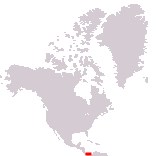Home > North America > Panamá

Republic of Panamá
República de Panamá
República de Panamá
Government type Presidential republic
Area 75,320 km² (29,081 sq mi)
Population 4,203,000 inh. (2023 census)
Population density 56 inh/km² (145 inh/mi²)
Area 75,320 km² (29,081 sq mi)
Population 4,203,000 inh. (2023 census)
Population density 56 inh/km² (145 inh/mi²)
Capital Panamá City (1,133,000 pop., 2,067,000 urban aggl.)
Currency Panamanian balboa, United States dollar
Human development index 0.805 (61st place)
Languages Spanish (official), English, indigenous languages
Life expectancy M 75 years, F 81 years
Currency Panamanian balboa, United States dollar
Human development index 0.805 (61st place)
Languages Spanish (official), English, indigenous languages
Life expectancy M 75 years, F 81 years

Boundaries:
Costa Rica WEST
Colombia SOUTH-EAST
Pacific Ocean SOUTH
Atlantic Ocean (Caribbean Sea) NORTH
GEOGRAPHY DATA OF PANAMA
Largest cities
Panamá City 1,133,000 pop., 2,067,000 urban aggl.
La Chorrera 206,000 pop.
Colón 159,000 pop.
Vista Alegre 129,000 pop.
David 104,000 pop.
Highest mountains
Volcán Barú 3,475 m (11,401 ft)
Longest rivers
Chucunaque 231 km (144 mi)
Tuira 230 km (143 mi)
Bayano 206 km (128 mi)
Largest lakes
Gatun Lake (artificial) 425 km² (164 sq mi)
Largest islands
Coiba 493 km² (190 sq mi)
Isla del Rey 234 km² (90 sq mi)
Cébaco 80 km² (31 sq mi)
Colón 61 km² (24 sq mi)
ADMINISTRATIVE DIVISIONS OF PANAMA
Panama is administratively divided into 10 provinces and 4 indigenous territories, called comarche; Darien, in the eastern extremity on the border with Colombia and South America, and Veraguas are the two largest provinces, both with an area greater than 10,000 km², while Panama is by far the most populated province, since it has over 1/3 of the population.Half of the 18 urban centers with at least 20,000 inhabitants are located in the immediate vicinity of the capital Panamá City, which hosts over 2 million people in its agglomeration; among the other cities we have one at the other mouth of the Panama Canal, on the Atlantic Ocean, as well as other inhabited centers in the western part of the country, with the easternmost provinces instead totally devoid of large settlements.
